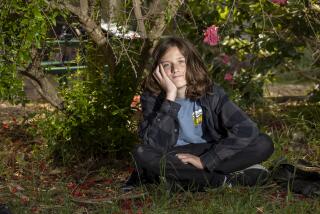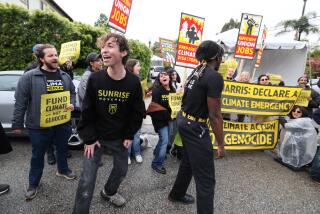On a Crusade
NORTH HILLS — Sixteen-year- old Craig Kielburger swept into the James Monroe High School auditorium, where more than 500 antsy teenagers were waiting Tuesday, and grabbed the microphone with the aplomb and flair of a talk-show host.
“The reason why I’m here is because of the comics,” the Toronto teenager told the crowd. “I was 12 years old, I was going downstairs to get the comics section, and a headline caught my eye.”
The accompanying story told of 12-year-old Iqbal Masih, a Pakistani boy who was sold into bondage as a carpet weaver at age 4, escaped at 10 to tell of his life chained to a loom and was murdered in 1995 at age 12 after winning several international prizes for his work.
“I was 12, and basically, I looked at his life, and I looked at mine,” Craig said. And the rest is history.
Craig photocopied the article about Iqbal, took the copies to school and handed them out to classmates. That night, 10 of them met over pizza and decided to form a network of children fighting for children. They called it “Free the Children.”
Four years later, Craig has made a career out of fighting child labor. He has traveled the world talking to street children and those who are paid almost nothing to work in substandard conditions, often to supply U.S. citizens with clothes and other products. He has testified before Congress and written a book, “Free the Children.”
He has spoken to prime ministers and executives and has been featured twice on “60 Minutes.” He hopes to have a career someday in “international conflict resolution.” Monday night, he addressed the AFL-CIO convention in Los Angeles.
Today, his organization boasts 100,000 members in 27 countries, he told the students at Monroe High School.
*
As he strode across the floor, swinging the microphone cord with ease, the boisterous teens were mesmerized.
He showed slides of 9-year-old Jeremy, a boy in the Philippines who has never set foot outside the trash dump where he was born, and of an 8-year-old girl in India, who squats over newspaper to sort through syringes and needles in a Madras recycling factory, dipping her hands into a dirty bucket of water to stop the bleeding when the used medical supplies pierce her skin.
“She had never heard of AIDS,” Craig said.
But his most important message, he said, is that kids can make a difference.
“Young people have power,” he said. “So many young people are told, you have to wait until you are 18, or when you are a judge, or a lawyer, to make a difference. No you don’t. Whether you are 12 or 16, you have the power to change the world.”
David Beiser, a coordinator for Free the Children USA, put it in even stronger terms: “This is about freeing children from the notion that they are powerless. That is even more true in this country, in a certain way. Kids laboring overseas in a way have more power. They are earning an integral part of the family budget.”
Two years ago, about 24 Monroe High students who attended the school’s law and government magnet program took their research to the Los Angeles Board of Education and persuaded the trustees to halt the purchase of soccer balls from Pakistan and other countries believed to be using child labor.
Several members of Free the Children read about the Monroe students on the Internet. They spoke with the school’s international law teacher, Mark Elinson, who taught the original class of Monroe activists and ultimately brought Craig to North Hills on Tuesday for the first time.
After Craig’s talk, students from Monroe and visiting students from Holmes Middle School, Venice High School and Sherman Oaks Center for Enriched Studies surged forward and crowded around the teen as if he were a rock star, pelting him with questions, asking for autographs and snapping pictures.
“It seems like our project this year is to start a chapter of Free the Children here,” said 17-year-old Noel Barajas, a senior in Elinson’s international law class. “I say start the chapter and start making a difference.”
There are about five Free the Children chapters in California, most of them in the Bay Area, but Elinson said he hoped students would start chapters this year at Monroe and other Valley schools. Students may also try to get companies who manufacture college-wear to use factories and subcontractors that do not use child labor, he said.
*
Some students were so fired up after the speech, they ran to Elinson with their ideas.
Christian Sanchez, 16, referred to a project undertaken by a Paso Robles school that filled boxes with Nike goods and mailed it to Nike’s chief executive officer, Philip Knight, demanding the company stop using child labor. In the past year, the company has raised the minimum age for employment at its footwear plants to 18.
“You know how he was talking about the labels and stuff?” Christian asked. “Why don’t we do something like that? Do you want me to bring in boxes tomorrow?”
Craig’s message is especially powerful at schools such as Monroe, where many students are from immigrant families in which the parents worked as children.
Christian said his father worked when he was a child in Guatemala, and told his son the income was important for his family.
“But I told him I can work to improve the conditions,” Christian said.
Other students were more skeptical.
“I don’t think he explained it well enough,” said Lucine Smbatian, 15, who said she is of Armenian descent. “He didn’t talk about what this will do to those countries’ economies. For example, Pakistan. Some percentage of their economy comes from soccer balls. If we don’t buy them, the whole country will be affected.”
More information on Free the Children can be found on the Internet at www.freethechildren.org.
More to Read
Sign up for Essential California
The most important California stories and recommendations in your inbox every morning.
You may occasionally receive promotional content from the Los Angeles Times.










